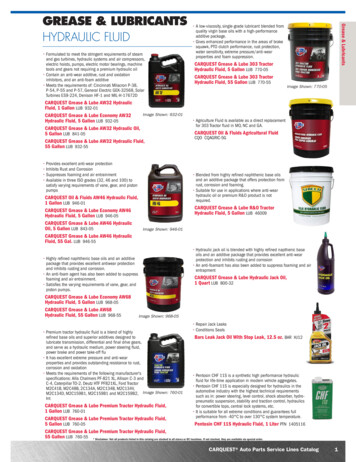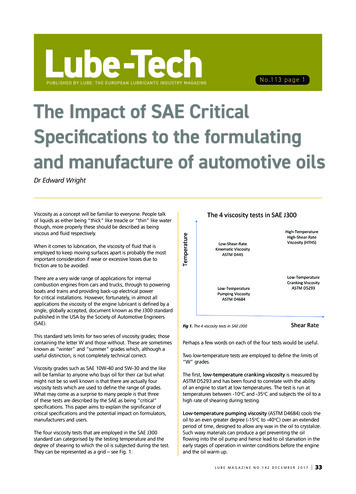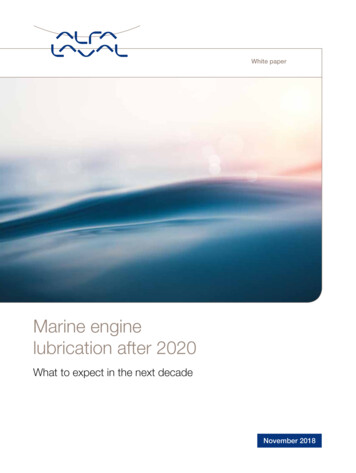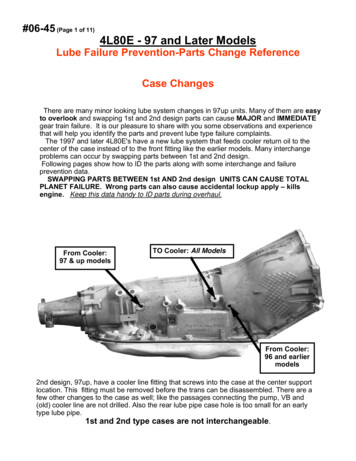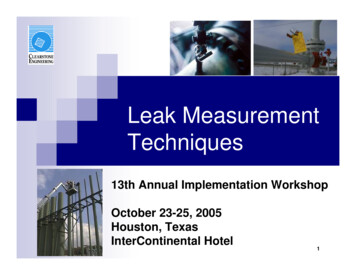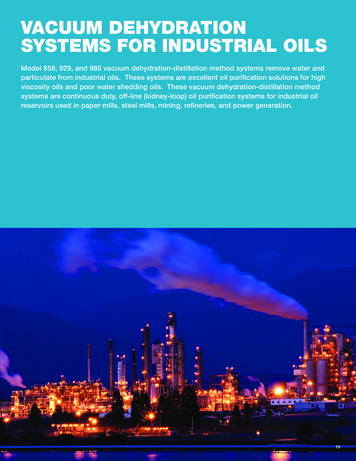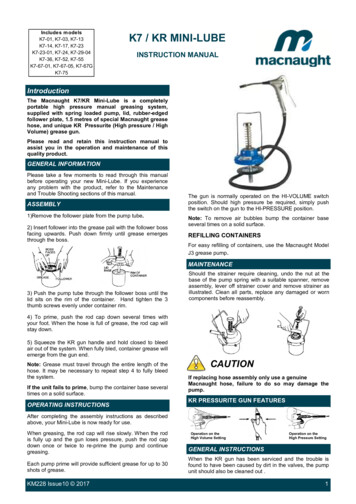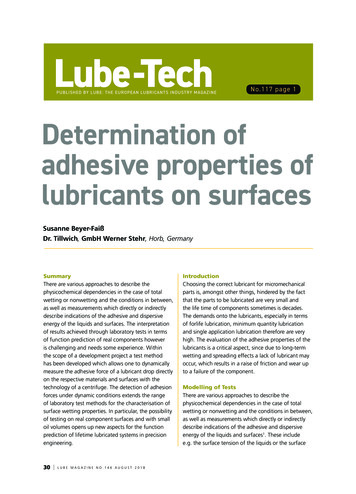
Transcription
Lube-Tech-PUBLISHED BY LUBE: THE EUROPEAN LUBRICANTS INDUSTRY MAGAZINENo.117 page 1Determination ofadhesive properties oflubricants on surfacesSusanne Beyer-FaißDr. Tillwich, GmbH Werner Stehr, Horb, GermanySummaryThere are various approaches to describe thephysicochemical dependencies in the case of totalwetting or nonwetting and the conditions in between,as well as measurements which directly or indirectlydescribe indications of the adhesive and dispersiveenergy of the liquids and surfaces. The interpretationof results achieved through laboratory tests in termsof function prediction of real components howeveris challenging and needs some experience. Withinthe scope of a development project a test methodhas been developed which allows one to dynamicallymeasure the adhesive force of a lubricant drop directlyon the respective materials and surfaces with thetechnology of a centrifuge. The detection of adhesionforces under dynamic conditions extends the rangeof laboratory test methods for the characterisation ofsurface wetting properties. In particular, the possibilityof testing on real component surfaces and with smalloil volumes opens up new aspects for the functionprediction of lifetime lubricated systems in precisionengineering.30LUBE MAGAZINE NO.146 AUGUST 2018IntroductionChoosing the correct lubricant for micromechanicalparts is, amongst other things, hindered by the factthat the parts to be lubricated are very small andthe life time of components sometimes is decades.The demands onto the lubricants, especially in termsof forlife lubrication, minimum quantity lubricationand single application lubrication therefore are veryhigh. The evaluation of the adhesive properties of thelubricants is a critical aspect, since due to long-termwetting and spreading effects a lack of lubricant mayoccur, which results in a raise of friction and wear upto a failure of the component.Modelling of TestsThere are various approaches to describe thephysicochemical dependencies in the case of totalwetting or nonwetting and the conditions in between,as well as measurements which directly or indirectlydescribe indications of the adhesive and dispersiveenergy of the liquids and surfaces1. These includee.g. the surface tension of the liquids or the surface
Lube-Tech-PUBLISHED BY LUBE: THE EUROPEAN LUBRICANTS INDUSTRY MAGAZINEenergy of the material surfaces. However, in thedirect contact of lubricant and surface, the interfacialtension dominates, which cannot be measureddirectly, and which only indirectly can be determinedvia the contact angle. If no equilibrium occurs at theinterface, the measurement is made more difficultbecause the contact angle decreases as a function oftime. Furthermore, in the field of precision mechanics,capillary forces are increasingly superimposing thewetting effects in narrow gaps, on rough surfaces andsmall drop volumes, and thus the transferability ofmeasuring results into practical application is difficult.Another point to consider is that under practicalrunning conditions of lubricated sliding bearings,frictional heat is created, which results in anacceleration of wetting processes due to Marangoniconvection effects2. The oil actively creeps out of thebearing (and lubrication zone respectively) onto coldersurfaces.In order to better assess long term wetting effects inreal parts, a method may be used, that allows oneto visualize even thin oil films on surfaces. With thereflection-contrast-equipment, oil droplets which, forexample, have been placed directly on the parts tobe lubricated, may be monitored. A camera placedover the test setup makes time lapse recordings tovisualise the effects which occur. Additionally, byraising the temperature of the test specimen, wettingand creeping effects can be accelerated, too. Resultsobtained give important information on the influenceof oil type, surface roughness, material, etc. In Figure1 four different situations are given of two oils, apolyglycol with high surface tension of 36mN/m(upper line) and a silicone oil with low surface tension(21mN/m, below), where droplets with oil volumesof 2µl have been placed on a glass slide, the left sidewith a smooth surface and the right side with a roughsurface. Only on the smooth surface, the polyglycoldroplet stays with a stable contact angle, on therough surface even the polyglycol begins to creepNo.117 page 2through the roughness. The silicone oil immediatelystarts to wet the surfaces, on the rough surface to amuch higher extent.Figure 1. Spreading behaviour of polyglycol (above) and silicone droplets(below) on glass with smooth (left) and rough surface (right)A typical exposure for lubricated fine mechaniccomponents is given in Figure 2. Here olephobiccoatings are used to realise forlife lubrication bya purposeful design of the contacting surfaces. Asilicone oil on a rough plastic surface remains therewith a stable contact angle, if a certain oleophobiclayer has been applied (lower part). On the nontreatedarea (upper part) the silicone oil wets completely.Figure 2. Spreading behaviour of silicone oil on a rough plastic surface with(zone below) and without olephobic coating (upper zone)LUBE MAGAZINE NO.146 AUGUST 201831
Lube-Tech-PUBLISHED BY LUBE: THE EUROPEAN LUBRICANTS INDUSTRY MAGAZINEThis test method gives a very good presentation ofdynamic wetting and creep effects, but if there arestable conditions at the interface between lubricantand surface, a further differentiation is difficult.Questions like “Is adhesion strong enough?”, or “Isthere even an oil repelling effect?”, “Is oil removeddue to gravity or centrifugal forces?”, cannot beanswered.No.117 page 3Dynamic Adhesion MeasurementWithin the scope of a development project3 a testmethod has been developed which allows one todynamically measure the adhesive force of a lubricantdrop directly on the respective materials and surfaces.The developed APG Adhesion Tester (Figure 3) isbased on the technology of a centrifuge.On a rotating disk maximum six standardised plates(size 76 x 26mm, Figure 4) out of any material (i.e.glass, metals, plastics) can be easily positioned withclamping claws. A pattern on the base of the diskwith different radii from 30 to 95 mm allows us tofind the correct position for the oil drops. Normally wework with three drops per radius.It is also possible to make tests on other componentsor parts by fixing them anywhere on the disk withshiftable magnetic strips (Figure 5). The shiftingforces of the magnets are higher than the maximumcentrifugal acceleration.Figure 3. APG Adhesion tester with rotating disk and dosing unit (swivelling)Figure 5. Easy fixing of varying forms of test specimen with magnetic stripsFigure 4. Rotating disk with test samples containing oil droplets ondifferent radii32LUBE MAGAZINE NO.146 AUGUST 2018Now oil droplets with a defined volume are selectivelypositioned on the material surfaces in different radii,and are subjected to different graduated centrifugalaccelerations (an varying from 1.1 to 41.7 m/s²) whenthe disk rotates. From the specific gravity, the dropvolume, the distance from the axis of rotation and the
Lube-Tech-PUBLISHED BY LUBE: THE EUROPEAN LUBRICANTS INDUSTRY MAGAZINENo.117 page 4To allow for easy comparative evaluation of series testsindependent of the mass of the drops, the so calledtransition factor is calculated, which is the normalacceleration when drops start to move, divided by thespecific gravity: transit an an/g.Test Plan and ResultsThe test plan for the comparative assessmentcomprised three base oils used as lubricants in finemechanics, a polyalphaolefin (surface tension s 30mN/m), an ester oil (s 32 mN/m), and a siliconeoil (s 21 mN/m). The materials used are glass withsurface roughnesses “smooth” (Ra 0,04µm, Rz0,45µm) and “rough” (Ra 0,91µm, Rz 7,91µm), apolyamide 66, a polybutylenetherephtalate and apolyacetale.The movement of the drops can be determinedoptically. If olephobic coatings with high concentrationare tested, the droplets move in total (Figure 6), thered dots represent the initial position of the drops. Ifuncoated surfaces are tested, the droplets leave tracesof smaller drops (Figure 7).In addition, the influence of an oleophobic surfacecoating in varying concentrations (10-high,50-medium high, 200-medium, 500-low) as used inforlife lubricated fine precision components on theadhesiveness of the lubricants has been tested. Dropvolumes varied from 0.2 to 1.5µl (Figure 8).rotational speed, the centrifugal force can now beprecisely determined, at which acceleration force thedrops are moving. At that point the adhesion forcemust be overcome respectively.Figure 8. Varying drop volumes for adhesion testsFigure 6. Transition point of droplets on oleophobic surfacesFigure 9. Influence of surface roughness on transit factorFigure 7. Transition point of droplets on non-coated surfacesThe influence of surface roughness and concentrationof oleophobic layers on the transit factor of silicone oilon glass is given in Figure 9.LUBE MAGAZINE NO.146 AUGUST 201833
Lube-Tech-PUBLISHED BY LUBE: THE EUROPEAN LUBRICANTS INDUSTRY MAGAZINENo.117 page 5On smooth surfaces the adhesion of the drops isnot affected by the concentration of the oleophobiclayer, whereas on rough surfaces the efficiency of theoleophobic layer decreases with the concentration. Butwhatever the concentration of the oleophobic layer,the adhesion of droplets on rough surfaces is twice ashigh as on smooth surfaces.Figure 11. Test specimen prepared for creeping barrier effectFigure 10. Influence of drop volume on transit factorIn Figure 10 the influence of drop volume andconcentration of oleophobic layers on the transitfactor of silicone oil on glass (smooth surface) is given.With reducing the drop volumes from 1µl to 0.2µl thetransit factors raise by a factor of 3.5.Another quite interesting aspect of using oleophobiclayers is to apply them as a creeping barrier for fluids.Here considerable volumes of fluids can be hinderedto step onto coated surfaces. In the test array of theAPG a silicone oil drop of 1.5µl was set exactly on theuncoated glass surface at the borderline to the coatedarea (Figure 11). When determining the transit factors,higher values are observed compared to tests whenplacing the droplets directly onto the oleophobic layer.Additionally a strong influence of the concentrationof the coating can be observed (Figure 12): higherconcentrations give higher barrier effect.34LUBE MAGAZINE NO.146 AUGUST 2018Figure 12. Influence of concentration of olephobic layer on transit factorOn the surfaces of plastic materials the adhesion oflubricants is quite different. Each base material andolephobic coating concentration acts specifically withthe respective lubricants. Trends may be observed,but each combination shows individual behaviour.So, for example, for each lubricant type used with acertain plastic material the optimum concentrationof the oleophobic layer can be determined havingthe highest adhesion. The transit factors of tests witha high concentration of oleophobic layer (10) anda medium concentration of oleophobic layer (200)examples are given in Figures 13 and 14.
Lube-Tech-PUBLISHED BY LUBE: THE EUROPEAN LUBRICANTS INDUSTRY MAGAZINENo.117 page 6extend the information that can be retrieved of thetest method. This includes the evaluation of thecentrifugal forces in relation to the circumferenceof drops, expressed as force per length and theevaluation of the adhesive forces based on thesurface tension of fluids and the circumferenceof drops. Materials to be evaluated are injectionmoulded plastic bars with different surface qualities(i.e. polished, grounded or eroded with variousroughnesses), commonly used for industriallyproduced functional parts.Figure 13. Influence of type of lubricant and type of plastic material(oleophobic coating 10-high concentration) on transit factorFigure 14. Influence of type of lubricant and type of plastic material(oleophobic coating 200-medium concentration) on transit factorConclusion and OutlookThe determination of adhesion forces under dynamicconditions extends the range of laboratory testmethods for the characterisation of surface wettingproperties. In particular, the possibility of testing onreal component surfaces and with small oil volumesopens up new aspects for the function prediction oflifetime lubricated systems in precision engineering.Current works now focus on the interfacial tensionbetween lubricants and material surfaces and so toReferences1 DIN 55660 Paints and varnishes; Wettability withParts 1, 2 and 3 (Dec. 2011), Parts 4 and 5 (Apr.2012, Parts 6 and 7 (Oct. 2014)2 Stehr, Werner: Spontanausfall von heiß-laufendenGleitlagern durch Ölverlust (Spontaneous failureof overheating sliding bearings due to oil losses).15. International Colloquium TRIBOLOGY, 17.-19.January 2006, Ostfildern, Germany3 ZIM Research Project KF 238 7401 DF9 Sept. 2009to Aug. 2011: Entwicklung eines Messgeräts zurdynamischen Prüfung der Adhäsionskräfte vonbeschichteten Festkörperoberflächen in Kontakt mitSchmierstoffen (Development of a test device todynamically test the adhesion forces of coated solidmaterial surfaces in contact with lubricants). Finalreport by Dr. Tillwich GmbH Werner StehrAcknowledgementsThe works in this project have been funded by theBMBF (German Federal Ministery of Education andResearch, ZIM Project KF 2387401 DF9).LINKwww.tillwich-stehr.comLUBE MAGAZINE NO.146 AUGUST 201835
32 LUBE MAGAZINE NO.146 AUGUST 2018 Lube--Tech PUBLISHED BY LUBE: THE EUROPEAN LUBRICANTS INDUSTRY MAGAZINE No.117 page 3 This test method gives a very good presentation of dynamic wetting and creep effects, but if there are
